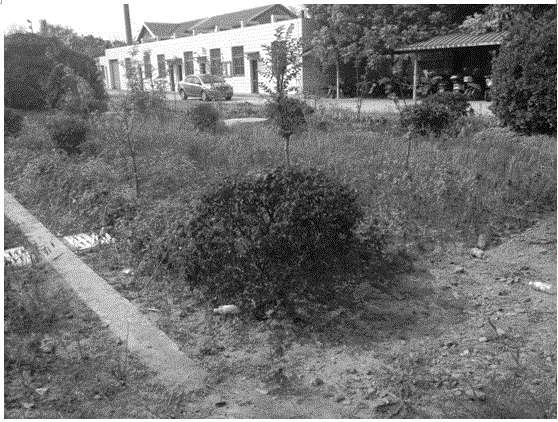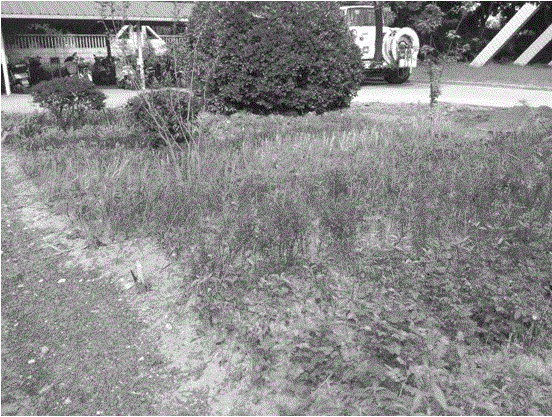Low-influence development and landscape growth medium, and preparation method and application thereof
A low-impact development and growth medium technology, applied in the field of environmental engineering, can solve the problems of landscape effect impact, restriction of plant selection, aggravation of groundwater pollution, eutrophication of rivers and lakes, etc., to achieve stable performance, improve water retention, and reduce odor Effect
- Summary
- Abstract
- Description
- Claims
- Application Information
AI Technical Summary
Problems solved by technology
Method used
Image
Examples
Embodiment 1
[0042] A growth medium for low-impact development and landscape production using dewatered sludge, the growth medium is composed of the following raw materials in parts by mass:
[0043] Coarse sand 60%;
[0044] Coconut peat 15%;
[0045] Dewatered sludge 20%;
[0046] Monazite sand 5%;
[0047] Wherein, the dewatered sludge has undergone biological deodorization and oxidation stabilization in advance, and has a water content of 40%; the content of lanthanide in the monazite sand is 28%.
[0048] The treatment method of biological deodorization and oxidation stabilization of the dewatered sludge is as follows:
[0049] (1) Spread the dewatered sludge with a moisture content of 50% on the treatment site to form a 15-20 cm thick mud layer;
[0050] (2) Dilute the compound enzyme with water in proportion, the concentration of the compound enzyme is 5ml / L, and spray it in the spread mud layer with a metering pump or other spraying equipment;
[0051] (3) Turn the mud layer o...
Embodiment 2
[0058] A growth medium for low-impact development and landscape production using dewatered sludge, the growth medium is composed of the following raw materials in parts by mass:
[0059] Coarse sand 50%;
[0060] Coconut peat 15%;
[0061] Dewatered sludge 25%;
[0062] Monazite sand 10%;
[0063] Wherein, the dewatered sludge has undergone biological deodorization and oxidation stabilization in advance, and has a water content of 40%; the content of lanthanide in the monazite sand is 35%.
[0064] The treatment method of the dewatered sludge and the preparation method of the growth medium in this example are the same as those in Example 1. In this example, the concentration of the compound enzyme is 8ml / L.
Embodiment 3
[0066] A growth medium for low-impact development and landscape production using dewatered sludge, the growth medium is composed of the following raw materials in parts by mass:
[0067] Coarse sand 55%;
[0068] Coconut peat 10%;
[0069] Dewatered sludge 30%;
[0070] Monazite sand 5%;
[0071] Wherein, the dewatered sludge has undergone biological deodorization and oxidation stabilization in advance, and has a water content of 40%; the content of lanthanide in the monazite sand is 35%.
[0072] The treatment method of the dewatered sludge and the preparation method of the growth medium in this example are the same as those in Example 1. In this example, the concentration of the compound enzyme is 10ml / L.
[0073] The growth medium prepared in Examples 1 to 3 is used to plant various plants, and the growth conditions of the plants can be found in the attached instructions. Figure 1-12 .
[0074] Examples 1 to 3 use biocatalysts to treat the sludge of urban sewage treat...
PUM
 Login to View More
Login to View More Abstract
Description
Claims
Application Information
 Login to View More
Login to View More - R&D
- Intellectual Property
- Life Sciences
- Materials
- Tech Scout
- Unparalleled Data Quality
- Higher Quality Content
- 60% Fewer Hallucinations
Browse by: Latest US Patents, China's latest patents, Technical Efficacy Thesaurus, Application Domain, Technology Topic, Popular Technical Reports.
© 2025 PatSnap. All rights reserved.Legal|Privacy policy|Modern Slavery Act Transparency Statement|Sitemap|About US| Contact US: help@patsnap.com



